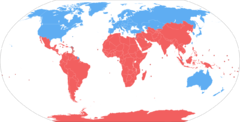Global North and Global South
 | |
The concept of Global North and Global South (or North–South divide in a global context) is used to describe a grouping of countries along the lines of socio-economic and political characteristics. The Global South is a term generally used to identify countries in the regions of Latin America, Africa, Asia and Oceania. Most of humanity resides in the Global South. Several countries in the Global South are characterised by low-income, dense population, poor infrastructure, often political or cultural marginalisation, and are on one side of the divide; while on the other side is the Global North (comprising the United States, Canada, Europe, Russia, Israel, Hong Kong, Macau, Japan, South Korea, Singapore, Taiwan, Australia, New Zealand and few others depending on context). As such, the terms Global North and Global South do not refer to the directional North-South as many of the Global South countries are geographically located in the Northern Hemisphere.[1]
Countries that are developed are considered as Global North countries, while those developing are considered as Global South countries. The term as used by governmental and developmental organisations was first introduced as a more open and value-free alternative to "Third World" and similarly potentially "valuing" terms like developing countries. Countries of the Global South have been described as newly industrialised or are in the process of industrialising, and are frequently current or former subjects of colonialism.[2]
The Global North generally correlates with the Western world—with the notable exceptions of Hong Kong, Macau, Israel, Japan, Singapore, South Korea and Taiwan—while the South largely corresponds with the developing countries and the Eastern world. The two groups are often defined in terms of their differing levels of wealth, economic development, income inequality, democracy, and political and economic freedom, as defined by freedom indices. States that are generally seen as part of the Global North tend to be wealthier and less unequal; they are developed countries, which export technologically advanced manufactured products. Southern states are generally poorer developing countries with younger, more fragile democracies heavily dependent on primary sector exports, and they frequently share a history of past colonialism by Northern states. Nevertheless, the divide between the North and the South is often challenged.[3]
South-South Cooperation (S-SC) has increased to "challenge the political and economic dominance of the North." This cooperation has become a popular political and economic concept following geographical migrations of manufacturing and production activity from the North to the Global South and the diplomatic action of several states, like China. These contemporary economic trends have "enhanced the historical potential of economic growth and industrialisation in the Global South," which has renewed targeted S-SC efforts that "loosen the strictures imposed during the colonial era and transcend the boundaries of postwar political and economic geography." Used in several books and American Literature special issue, the term Global South, recently became prominent for US literature.[4]
Related Quotation
| Page | Quote | Author |
|---|---|---|
| Michael Oppenheimer | “The only hope for the world is to make sure there is not another United States. We can’t let other countries have the same number of cars, the amount of industrialisation we have in the U.S. We have to stop these Third World countries right where they are.” | Michael Oppenheimer |
Related Document
| Title | Type | Publication date | Author(s) | Description |
|---|---|---|---|---|
| Document:Why Much of the Global South Isn’t Automatically Supporting the West in Ukraine | Article | 28 February 2023 | Krishen Mehta | "The BRICS are not imposing sanctions on Russia nor supplying arms to the opposing side. While Russia is the biggest supplier of energy and foodgrains for the Global South, China remains the biggest supplier of financing and infrastructure projects to them through the Belt and Road Initiative. And now Russia and China are closer than ever before because of the war." |
References
Wikipedia is not affiliated with Wikispooks. Original page source here